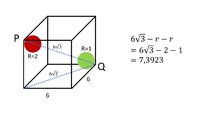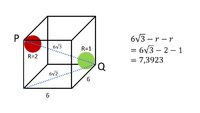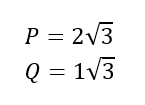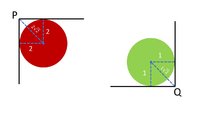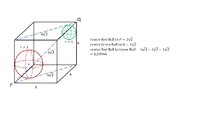Points P and Q are the two opposite vertices of a cube with an edge length 6. Two balls of radii 1 and 2 are inside of the cube. One of them touches all the three faces of the cube containing P and another touches all the three faces containing Q. Find the distance between the balls' centers.
You are using an out of date browser. It may not display this or other websites correctly.
You should upgrade or use an alternative browser.
You should upgrade or use an alternative browser.
Trigonometry
- Thread starter ikmalamki
- Start date
Dr.Peterson
Elite Member
- Joined
- Nov 12, 2017
- Messages
- 16,084
How long is the diagonal of the cube, PQ?
How far is the center of each ball from P or Q?
How far is the center of each ball from P or Q?
please correct me.Surely, you've tried SOEMTHING. Please share.
Attachments
diagonal PQ=6\sqrt(3)How long is the diagonal of the cube, PQ?
How far is the center of each ball from P or Q?
please correct me.If point P is at the origin, what are the co-ordinates of point Q?
What might you do next?
Attachments
Dr.Peterson
Elite Member
- Joined
- Nov 12, 2017
- Messages
- 16,084
You have the right length for the diagonal, but the balls do not pass through the endpoints of the diagonal! You need to subtract something different. Answer my second question:please correct me.
How far is the center of each ball from P or Q?
- Joined
- Apr 12, 2005
- Messages
- 11,339
Nice first try. You should have included this in the very first post.please correct me.
You have overlooked that your spheres do NOT go all the way to their respective corners.
Dr.Peterson
Elite Member
- Joined
- Nov 12, 2017
- Messages
- 16,084
That doesn't mean what you think it means. P and Q are points, not numbers.oke i understand, so center of each ball is
View attachment 23409
But those are the distances of the centers from P and Q, respectively. So how far are the centers from each other?
(By the way, post #3 gave a hint at what would turn out to be an easier approach overall, but we're well on the way to an answer.)
this is true ?That doesn't mean what you think it means. P and Q are points, not numbers.
But those are the distances of the centers from P and Q, respectively. So how far are the centers from each other?
(By the way, post #3 gave a hint at what would turn out to be an easier approach overall, but we're well on the way to an answer.)
Attachments
Dr.Peterson
Elite Member
- Joined
- Nov 12, 2017
- Messages
- 16,084
The pictures are accurate side views (though they don't show everything that is relevant). Why didn't you keep going to a solution?this is true ?
oke sirThe pictures are accurate side views (though they don't show everything that is relevant). Why didn't you keep going to a solution?
I agree with Dr. Peterson that you are close enough to a solution that there is no point NOW in using analytic geometry, but what it would have kept firmly in your mind is that you are dealing with three dimensions rather than two. A two dimensional diagram may hide something that is relevant.
Dr.Peterson
Elite Member
- Joined
- Nov 12, 2017
- Messages
- 16,084
You've got the wrong distances to P and Q, probably for the reason JeffM was concerned about.
Have you noticed that each ball's center can be thought of as being at the opposite corner of a small cube from P or Q?
Have you noticed that, as a result, each of those centers lies on the diagonal?
If not, then you may need to revert to the coordinate approach, which may require less visualization.
Have you noticed that each ball's center can be thought of as being at the opposite corner of a small cube from P or Q?
Have you noticed that, as a result, each of those centers lies on the diagonal?
If not, then you may need to revert to the coordinate approach, which may require less visualization.
jonah2.0
Full Member
- Joined
- Apr 29, 2014
- Messages
- 534
Beer soaked query follows.
He/she almost had it.
I wonder what happened to ikmalamki.my last answer, please.
He/she almost had it.

